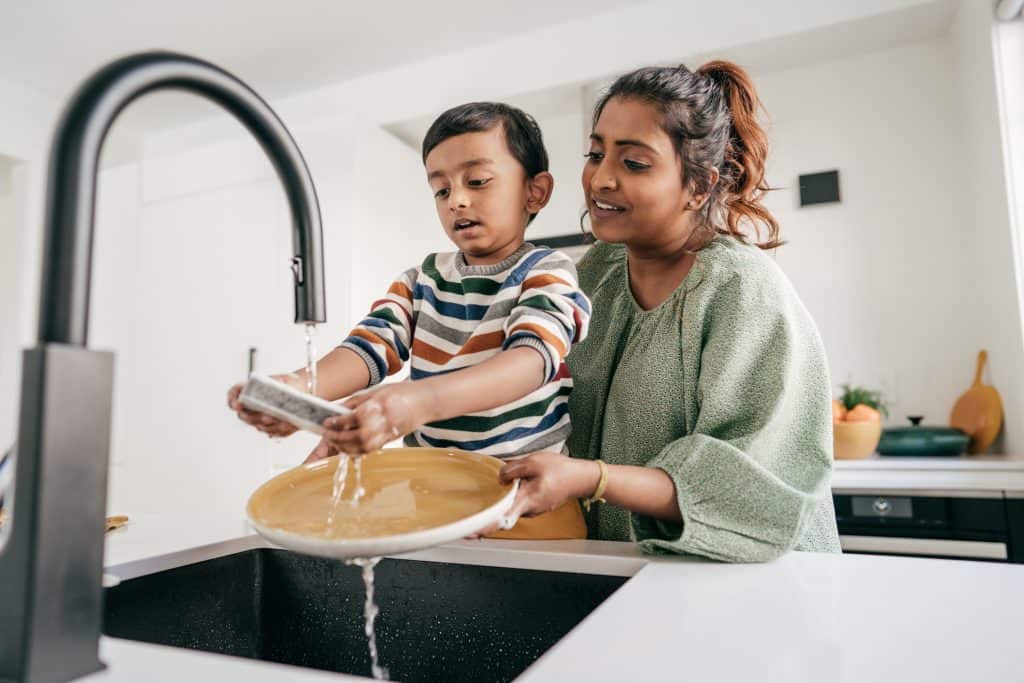What is habit stacking? Habit stacking is a productivity technique that helps you to create new habits by linking them to existing habits.[1] These existing habits can be little things you might not already think about, like having breakfast or doing a chore. Your existing habit then acts as a cue for the new one, making it easier to remember and practice.[2]
Habit stacking was popularized by self-improvement authors S.J. Scott and James Clear, and it is a helpful way for families to think about creating routines for their little ones. Family routines help children feel safe by making things predictable, and they can help children learn how to organize their day.[3] Habit stacking can help you create strong household routines with your child.
Interested in habit stacking, but not sure where to begin? Start with these 7 habit stacking tips, and you’ll start adding lasting habits to your existing family routines.
7 Tips for Building a Family Routine with Habit Stacking
1. Brainstorm new and existing habits with your family.
When you are thinking about the new habits you want to add to your family routine, it can help to think about what habits you’re already doing well. Together with your family, brainstorm a list of the habits you already practice and ideas for new habits you would like to stack.[4] Making a list of the habits you already have will help you see where you can attach new ones.
You can use this family calendar template to record existing habits and the new habits you’ll stack on your routine.
2. Choose an existing habit and add one new habit.
To start out, choose a small habit that you would like to add to your family’s routine—ideally one that takes five minutes or less.[5] Then, choose a habit you already have and use it as a cue to do the new habit. The new habit can come before or after the existing habit.
For example, your new habit could be to read a picture book with your child every night before bedtime. Decide which existing bedtime habit you want to add to—such as brushing teeth or tucking your child into bed— and plan to read the picture book after one of those existing habits.
3. Make your new habit measurable.
Setting up clear requirements around your new habit will make it more effective.[6] “Read more picture books together,” for example, is hard to track. A more specific habit, like “read one picture book every night before turning out the light,” will be easier to stack—and track.
4. Be specific with your stacking cues.
According to Atomic Habits author James Clear, vague cues like “after taking a break during the day” make it difficult to establish consistent habits.[7] Choose a specific habit that you do during the same time every day. Instead of “after school,” for example, you could make your child’s habit cue for doing their homework, “after my child comes home and hangs up their backpack.”
5. Start slow.
Once you’ve added one new habit to your routine, it can be tempting to add a bunch more all at once. But habit stacking is all about slow and steady progress, which is better for making lasting changes to your routine.[8]
The point of habit stacking is that adding one new habit at a time will make it stick more easily. Focus on one at a time, allowing your family a week or two of practicing the new habit before adding another one.
6. Begin each day with the most important habits.
In an article with Forbes, Declutter Your Brain author S.J. Scott recommends adding the most urgent or important habits into your morning routine to get the day started right.[1] For instance, if your child is struggling in math class, you could practice the math facts they are working on for a few minutes every day after they put their finished breakfast plate in the sink. That way, they can go to school with a little more confidence and build their skills over time.
7. Celebrate small victories.
Adding a new habit to your family routine is a big deal, no matter how small it seems. As you complete a new habit you are practicing, put a checkmark on your daily calendar to track your progress. That way, you can see how much improvement you are making over time.
Congratulate your little ones on sticking to a new habit and reward them for their hard work.[9] For example, if you read a picture book every day to your child for two weeks, reward them with a trip to your local library or bookstore.
Sources:
1. Kruse, K. Could ‘Habit Stacking’ Be The Key To Better Results? Forbes. July 10, 2017. https://www.forbes.com/sites/kevinkruse/2017/07/10/could-habit-stacking-be-the-key-to-better-results/?sh=11ada6e04fb3.
2. Seaver, M. Habit Stacking Is the Easiest Way to Make New Habits Last—Here’s How It Works. Real Simple. February 1, 2022. https://www.realsimple.com/work-life/life-strategies/inspiration-motivation/habit-stacking.
3. Raising Children Staff. Family routines: how and why they work. https://raisingchildren.net.au/grown-ups/family-life/routines-rituals-relationships/family-routines
4. Barfield, K. Habit Stacking — A Different Approach to Behavior Coaching. National Academy of Sports Medicine. February 10, 2022. https://blog.nasm.org/fitness/habit-stacking.
5. The Dad Train Staff. Habit Stacking: The secret trick for remembering to do things. October 9, 2019. https://thedadtrain.com/habit-stacking/.
6. Painter, K. Want to adopt a healthy new habit? ‘Stack’ it. USA Today. August 25, 2015. https://www.dartmouth.edu/wellness/docs/september_archive.pdf.
7. Clear, J. How to Build New Habits by Taking Advantage of Old Ones. Excerpt from Atomic Habits. https://jamesclear.com/habit-stacking.
8. Frost, A. Can’t Find Time For Self-Care? Try ‘Habit Stacking.’ Huffington Post. November 11, 2021. https://www.huffpost.com/entry/self-care-habit-stacking_l_618be990e4b0c8666be5799c.
9. Boksic, B. 13 Steps to Build a Positive Habit Stacking Routine. Lifehack. September 2, 2021. https://www.lifehack.org/855944/habit-stacking.



